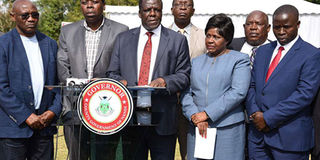Regional economic blocs are doomed to fail

Kakamega Governor Wycliff Oparanya addresses the press during the third Lake Region Economic Bloc summit at Nandi Bears Clun, Nandi County, on September 21, 2018. PHOTO | JARED NYATAYA | NATION MEDIA GROUP
What you need to know:
- The whole idea is incomplete without some sort of enforcement mechanism, such as a border patrol force, a customs authority, and, perhaps, even a tax authority.
- Unless all counties also embrace the successful county’s best practices, it follows that the initially successful model ends up being overburdened and may be doomed to collapse without national level support.
Over the past few years there has been a craze of counties coming together to form ‘regional economic blocs’.
One of the most visible of these blocs, the Lake Region Economic Bloc (LREB), is said to bring together 14 counties around Lake Victoria, and on its website indicates that its objective is to ‘leverage the economies of scale and shared resources such as Lake Victoria in order to grow the economies of the region and improve the livelihood of the people’.
A key project of this bloc is to set aside money to create a regional bank.
The ‘regional bloc’ idea presupposes a number of things, the most important one being that counties are independent economic units making their own economic policy and capable of creating and implementing economic and trade barriers against other similarly independent counties.
The rationale of coming together as a bloc, therefore, would be to minimise and eliminate such barriers and implement free movement of resources across county boundaries.
DEVOLUTION
In fact, the whole idea is incomplete without some sort of enforcement mechanism, such as a border patrol force, a customs authority, and, perhaps, even a tax authority.
The formation of some sort of ‘state-owned’ or ‘Central Bank’ would then make sense under these conditions.
Unfortunately, the ideals undergirding the ‘regional bloc’ movement run completely counter to the letter and spirit of our Constitution.
Read together, Articles 4, 5, and 6 of the Constitution are unambiguous, that Kenya is a unitary state with government at two levels — national and county.
The two levels are both distinct and interdependent, and the functions of each level of government are enumerated in the Fourth Schedule.
The whole idea of devolution and the sharing of powers at national and county levels is to improve service to the entirety of the Kenya populace, rather than to sections of it depending on their geography and history.
HEALTH
A good example of the pitfalls of misinterpreting the Constitution as creating 47 independent states lies in the health sector, where some counties have developed very good health systems to serve their own residents.
Unfortunately, due to the fact that counties do not have ‘hard’ boundaries and cannot lawfully restrict movement of Kenyans across county boundaries, these good health facilities have attracted patients from neighbouring counties.
Unless all counties also embrace the successful county’s best practices, it follows that the initially successful model ends up being overburdened and may be doomed to collapse without national level support.
It is obvious to any observer that the premise on which these regional economic blocs are founded is fatally flawed and cannot withstand the weight of constitutional scrutiny.
The fact that the idea appears attractive to many, perhaps, suggests that the unit of organisation of the second level of government needs to be revised to a supra-county entity, perhaps a region, within which the counties would then become local administrative units.
Prof Atwoli is associate professor of psychiatry and dean, Moi University School of Medicine; [email protected]





